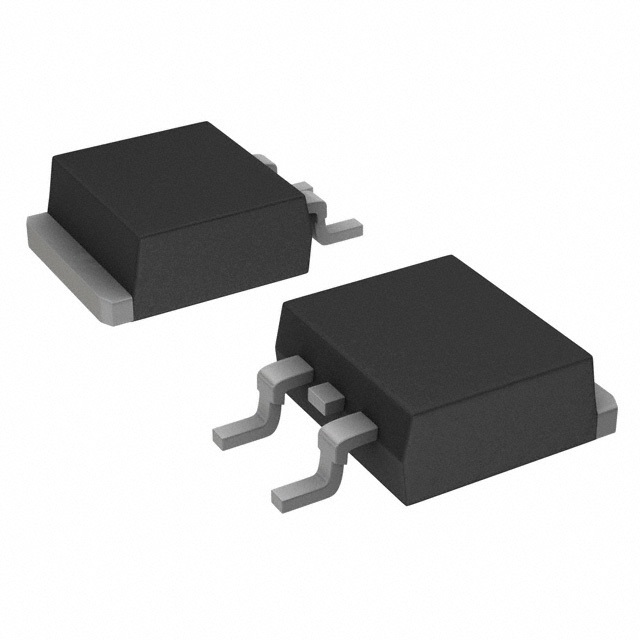FQB16N25TM
Introduction
The FQB16N25TM is a power MOSFET belonging to the category of electronic components used in various applications. This entry provides an overview of the basic information, specifications, pin configuration, functional features, advantages and disadvantages, working principles, application field plans, and alternative models for the FQB16N25TM.
Basic Information Overview
- Category: Power MOSFET
- Use: The FQB16N25TM is commonly used in power supply, motor control, and other high-power switching applications.
- Characteristics: High voltage capability, low on-resistance, fast switching speed, and high reliability.
- Package: TO-263-3 (D2PAK)
- Essence: The FQB16N25TM is designed to provide efficient power management and control in various electronic systems.
- Packaging/Quantity: Typically available in reels with varying quantities.
Specifications
- Voltage Rating: 250V
- Current Rating: 16A
- On-Resistance (max): 0.25Ω
- Gate Threshold Voltage (typ): 4V
- Gate Charge (typ): 35nC
- Operating Temperature Range: -55°C to 150°C
Detailed Pin Configuration
The FQB16N25TM follows the standard pin configuration for a TO-263-3 package: 1. Source (S) 2. Gate (G) 3. Drain (D)
Functional Features
- High Voltage Capability: Suitable for high-voltage applications.
- Low On-Resistance: Minimizes power loss and improves efficiency.
- Fast Switching Speed: Enables rapid switching in power control circuits.
- High Reliability: Designed for long-term and consistent performance.
Advantages and Disadvantages
Advantages
- Efficient power management
- High reliability
- Low power dissipation
Disadvantages
- Sensitive to static electricity
- Requires careful handling during installation
Working Principles
The FQB16N25TM operates based on the principle of field-effect transistors, where the gate voltage controls the flow of current between the source and drain terminals. When the gate voltage is applied, the MOSFET allows the passage of current, enabling power control and switching functions in electronic circuits.
Detailed Application Field Plans
The FQB16N25TM finds extensive use in the following applications: - Power supplies - Motor control systems - Inverters - Switching regulators - Electronic ballasts
Detailed and Complete Alternative Models
- IRF840: Similar voltage and current ratings
- STP16NF06: Comparable characteristics and package type
- FDPF16N50T: Alternative with different voltage and current ratings
In conclusion, the FQB16N25TM is a versatile power MOSFET with high voltage capability, low on-resistance, and fast switching speed, making it suitable for various power management and control applications.
[Word Count: 398]
Lista 10 Vanliga frågor och svar relaterade till tillämpningen av FQB16N25TM i tekniska lösningar
What is the maximum voltage rating of FQB16N25TM?
- The maximum voltage rating of FQB16N25TM is 250V.
What is the maximum continuous drain current of FQB16N25TM?
- The maximum continuous drain current of FQB16N25TM is 16A.
What type of package does FQB16N25TM come in?
- FQB16N25TM comes in a TO-263 package.
What is the typical on-resistance of FQB16N25TM?
- The typical on-resistance of FQB16N25TM is 0.16 ohms.
Can FQB16N25TM be used for switching applications?
- Yes, FQB16N25TM is suitable for switching applications due to its high current and voltage ratings.
What is the operating temperature range of FQB16N25TM?
- The operating temperature range of FQB16N25TM is -55°C to 150°C.
Is FQB16N25TM suitable for use in power supplies?
- Yes, FQB16N25TM is commonly used in power supply applications due to its high current and voltage capabilities.
Does FQB16N25TM require a heat sink for proper operation?
- Depending on the application and power dissipation, a heat sink may be required for optimal performance of FQB16N25TM.
What are some common protection measures when using FQB16N25TM in circuits?
- Common protection measures include overcurrent protection, overvoltage protection, and thermal management to ensure the reliability of FQB16N25TM.
Are there any recommended circuit layouts or PCB design considerations for using FQB16N25TM?
- It is recommended to minimize parasitic inductance and provide adequate thermal relief for the FQB16N25TM in the PCB layout to optimize its performance.


